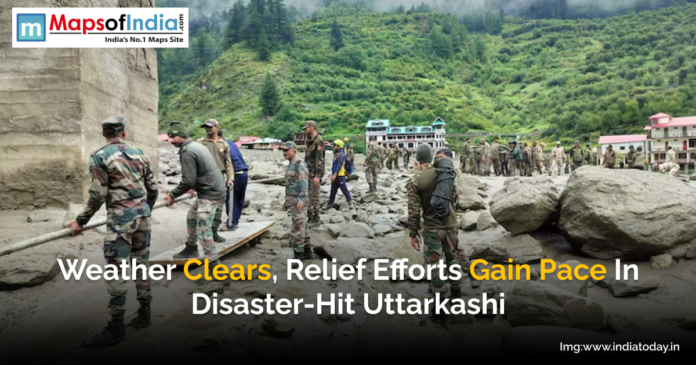A clear Thursday morning came as a welcome relief to the disaster-afflicted Uttarkashi, and a new breath of hope all over the area came sweeping in with clearer skies. Now that the weather had cleared up, the rescue and relief efforts, which had stalled earlier, continued to gain pace, and trapped locals could be brought out, and relief flowed into the affected communities.
In Dharali, a place badly hit by flash floods, SDRF, NDRF, Army and ITBP responded on a war footing. Large clusters of debris were quickly removed by heavy machinery, such as JCBs, cranes, and generators, as the teams set up portable command posts in areas of critical infrastructure. An improvised bridge was built, and road connectivity between Bhatawari and Ganganani on Gangotri Highway was once again established due to the quick work done by BRO, giving the opportunity to ferry the trapped vehicles and people.
There were magnum problems of communication outages, but relief was on its way in the form of Chinook helicopters that were carrying 125 kV generators to Dharali, which would be a big step forward, making the supply of electricity and telecom services possible. At the same time, both Chinook and MI-17 helicopters gave airborne support, which is now based at Chinyalisaur to act more swiftly, and transport rescuers, supplies and medical equipment to the distant areas.
On the health front, medical teams established camps at Dharali and Harsil, where more than 70 of the wounded were treated. Five serious cases were air lifted to AIIMS Rishikesh and Dehradun Medical College, where they will be further treated. It was realized that the disaster was taking a toll psychologically, and so three health personnel in the field of mental health were released to offer counselling to the affected persons.
Officials at the state level were undeterred: the IAS Association announced that it would donate one day’s salary to the Chief Minister’s Relief Fund. Top administrators kept track of every rescue and recovery action, coordinating all the agencies involved.
Adding to these initiatives, there was a coordinated effort between the central and state governments to deliver the much-needed resources by air and road to ensure the delivery of food, animal feed and medicines. In the short run, they are concerned with reviving essential services and the safety of both the rehabilitation and the affected populations.
Thursday was good, fine weather; a critical turning point. This newfound access, air power, and ground coordination have brought up new vigor in the relief corruption. When so much is at stake in terms of the number of lives, convergence of formulated rescue plans and clear skies has brought new hope to the heart of the disaster scene in Uttarkashi.










